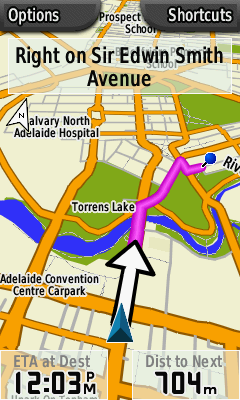Garmin/Colorado series
| Garmin Colorado 300 | |||||
|---|---|---|---|---|---|
| Description | |||||
| GNSS | channels | ||||
| Memory | Internal: . | ||||
| Features |
| ||||
A series of devices introduced at the beginning of 2008, available in a few different versions that vary in installed maps (and internal memory), but now apparently on the way out, being replaced by the touch-series Oregon and Dakota.
A nice device with an apparently fast and accurate chip. It is well-built unit, with quite a substantial feel to it. The main case is metal with a plastic back that slides over the battery and SD card slot. However, the internal seal is (once again) a problem, as after a few months of use it becomes loose and I doubt that my unit is watertight at all any more. Apparently the Oregon series has solved this problem with a different design of the back cover.
The display is large and has a high-resolution, however it can be difficult to read in sunlight without the battery-draining backlight on.
While the hard-ware seems overall well made, this cannot be said of the software. When I got the unit at the beginning of 2008 I thought with such buggy software the Colorado series should have never left the factory gates. Garmin has over the time, quite sluggishly I must say, release quite a few software updates. However, many of the nice touches that characterised the etrex series are still missing, such as change of display colours at night, different sounds for different events (such as loss of satellite lock), changing number of data fields shown.
The latest releases of the software added the ability to display raster data maps, such as satellite imagery or other user-made maps, but it is quite limited regarding the size of the maps and there is no provision for different resolutions.
Battery life is still nowhere as advertised, I struggle to get more than 5 to 6 hours out of two fully charged 2600mA AA batteries. A simple solution, to turn the screen off after a few minutes of non-use seems to have never entered Garmin's mind.
Other problems are a sometimes serious drift in location, which the unit seems unable to fix. It can take a few minutes of being very much off-course before the unit slowly returns to the right track. As other devices are able to record the track correctly, this has nothing to do with satellite constellation.
The Colorado shares with the etrex series the annoying habit of extrapolating a track for about 90 seconds after a satellite lock is lost -- leading to those tracks straight up a hillside when travelling in mountainous countries or urban canyons. Other units, such as the GlobalSat Datalogger, do not do this and turn off track-logging as soon as contact with satellites is lost -- Garmin should at least consider this behaviour as an option as it is nothing but cosmetic gimmickry that is difficult to edit out.
Tracklogs are recorded in GPX format on the build-in memory. The unit automatically archives the track once in a while and up to 20 such archive files are kept. It is not possible to archive tracks on the SD card however and on longer trips I have lost tracks because of the Colorado deleting the earlier files. This is a purely software introduced limitation, there was plenty of free memory and devices like the Oregon store the last 200 tracks. Storing on an SD card would have the potential of removing all limits, but Garmin has chosen not to. Annoying. It would be good if Garmin added the GPS accuracy, number of satellites, or HDOP/VDOP as a field to the GPX data -- that would allow screening out unreliable data.
The Colorado has (finally!) removed the idiotic limitation of only being able to display a maximum of four map files, all .img files are now being displayed. The built-in hillshaded basemap is quite nice, but it is a shame that it comes in one with the road basemap, meaning that with OSM data on it, you will get the quite inaccurate and rough garmin basemap and OSM data at the same time.
The early iPod inspired wheel was certainly a mistake, it is quick for zooming in and out and works well if using the Colorado on a bike, but for text entry the wheel is close to unusable.
There is a issue tracker for the Colorado at [1] for those who need to know more.
My recommendation: particularly as there are newer units out, such as the Dakota or Oregon, give the Colorado a miss.

